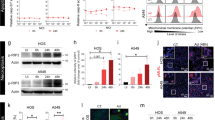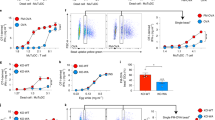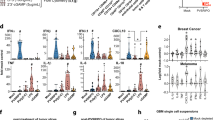Abstract
Dendritic cells (DCs) are the most potent antigen-presenting cells and acquire cellular antigens and danger signals from dying cells to initiate antitumor immune responses via direct cell-to-cell interaction and cytokine production. The optimal forms of tumor cell death for priming DCs for the release of danger signals are not fully understood. OBP-301 (Telomelysin) is a telomerase-specific replication-competent adenovirus that induces selective E1 expression and exclusively kills human cancer cells. Here, we show that OBP-301 replication produced the endogenous danger signaling molecule, uric acid, in infected human tumor cells, which in turn stimulated DCs to produce interferon-γ (IFN-γ) and interleukin 12 (IL-12). Subsequently, IFN-γ release upregulated the endogenous expression of the proteasome activator PA28 in tumor cells and resulted in the induction of cytotoxic T-lymphocytes. Our data suggest that virus-mediated oncolysis might be the effective stimulus for immature DCs to induce specific activity against human cancer cells.
This is a preview of subscription content, access via your institution
Access options
Subscribe to this journal
Receive 50 print issues and online access
$259.00 per year
only $5.18 per issue
Buy this article
- Purchase on Springer Link
- Instant access to full article PDF
Prices may be subject to local taxes which are calculated during checkout





Similar content being viewed by others
References
Aliberti J, Viola JP, Vieira-de-Abreu A, Bozza PT, Sher A, Scharfstein J . (2003). Bradykinin induces IL-12 production by dendritic cells: a danger signal that drives Th1 polarization. J Immunol 170: 5349–5353.
Bartholomae WC, Rininsland FH, Eisenberg JC, Boehm BO, Lehmann PV, Tary-Lehmann M . (2004). T cell immunity induced by live, necrotic, and apoptotic tumor cells. J Immunol 173: 1012–1022.
Glantzounis GK, Tsimoyiannis EC, Kappas AM, Galaris DA . (2005). Uric acid and oxidative stress. Curr Pharm Des 11: 4145–4151.
Ho LJ, Wang JJ, Shaio MF, Kao CL, Chang DM, Han SW et al. (2001). Infection of human dendritic cells by dengue virus causes cell maturation and cytokine production. J Immunol 166: 1499–1506.
Hu DE, Moore AM, Thomsen LL, Brindle KM . (2004). Uric acid promotes tumor immune rejection. Cancer Res 64: 5059–5062.
Kawashima T, Kagawa S, Kobayashi N, Shirakiya Y, Umeoka T, Teraishi F et al. (2004). Telomerase-specific replication-selective virotherapy for human cancer. Clin Cancer Res 10: 285–292.
Lenaerts L, Naesens L . (2006). Antiviral therapy for adenovirus infections. Antiviral Res 71: 172–180.
Lindenmann J, Klein PA . (1967). Viral oncolysis: increased immunogenicity of host cell antigen associated with influenza virus. J Exp Med 126: 93–108.
Manjili MH, Park J, Facciponte JG, Subjeck JR . (2005). HSP110 induces ‘danger signals’ upon interaction with antigen presenting cells and mouse mammary carcinoma. Immunobiology 210: 295–303.
Shi Y, Evans JE, Rock KL . (2003). Molecular identification of a danger signal that alerts the immune system to dying cells. Nature 425: 516–521.
Sijts A, Sun Y, Janek K, Kral S, Paschen A, Schadendorf D et al. (2002). The role of the proteasome activator PA28 in MHC class I antigen processing. Mol Immunol 39: 165–169.
Steinman RM, Turley S, Mellman I, Inaba K . (2000). The induction of tolerance by dendritic cells that have captured apoptotic cells. J Exp Med 191: 411–416.
Sun Y, Sijts AJ, Song M, Janek K, Nussbaum AK, Kral S et al. (2002). Expression of the proteasome activator PA28 rescues the presentation of a cytotoxic T lymphocyte epitope on melanoma cells. Cancer Res 62: 2875–2882.
Taki M, Kagawa S, Nishizaki M, Mizuguchi H, Hayakawa T, Kyo S et al. (2005). Enhanced oncolysis by a tropism-modified telomerase-specific replication-selective adenoviral agent OBP-405 (‘Telomelysin-RGD’). Oncogene 24: 3130–3140.
Umeoka T, Kawashima T, Kagawa S, Teraishi F, Taki M, Nishizaki M et al. (2004). Visualization of intrathoracically disseminated solid tumors in mice with optical imaging by telomerase-specific amplification of a transferred green fluorescent protein gene. Cancer Res 64: 6259–6265.
Watanabe T, Hioki M, Fujiwara T, Nishizaki M, Kagawa S, Taki M et al. (2006). Histone deacetylase inhibitor FR901228 enhances the antitumor effect of telomerase-specific replication-selective adenoviral agent OBP-301 in human lung cancer cells. Exp Cell Res 312: 256–265.
Acknowledgements
We thank Drs Tamotsu Yoshimori and Frank McCormick for providing pLC3-GFP plasmid and Onyx-015, respectively.
The study was supported by Grants-in-Aid from the Ministry of Education, Science and Culture, Japan; and Grants from the Ministry of Health and Welfare, Japan.
Author information
Authors and Affiliations
Corresponding author
Additional information
Supplementary Information accompanies the paper on the Oncogene website (http://www.nature.com/onc).
Rights and permissions
About this article
Cite this article
Endo, Y., Sakai, R., Ouchi, M. et al. Virus-mediated oncolysis induces danger signal and stimulates cytotoxic T-lymphocyte activity via proteasome activator upregulation. Oncogene 27, 2375–2381 (2008). https://doi.org/10.1038/sj.onc.1210884
Received:
Revised:
Accepted:
Published:
Issue Date:
DOI: https://doi.org/10.1038/sj.onc.1210884
Keywords
This article is cited by
-
Overview of the pre-clinical and clinical studies about the use of CAR-T cell therapy of cancer combined with oncolytic viruses
World Journal of Surgical Oncology (2022)
-
Biological causes of immunogenic cancer cell death (ICD) and anti-tumor therapy; Combination of Oncolytic virus-based immunotherapy and CAR T-cell therapy for ICD induction
Cancer Cell International (2022)
-
Prospects for combined use of oncolytic viruses and CAR T-cells
Journal for ImmunoTherapy of Cancer (2017)
-
Role of autophagy in oncolytic herpes simplex virus type 1-induced cell death in squamous cell carcinoma cells
Cancer Gene Therapy (2017)
-
Immunogenic cell death by oncolytic herpes simplex virus type 1 in squamous cell carcinoma cells
Cancer Gene Therapy (2016)



